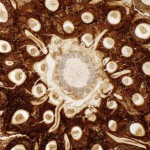 The internal tissues of the fossilized fern. Benjamin Bomfleur A violent death has led to a remarkably lucky preservation. Researchers in Sweden have discovered ferns that were buried suddenly in a volcanic eruption during the Jurassic period. The sudden burial has preserved stunning details of the fern, down to showing the plant’s chromosomes being separated during cell division. In fact, the details are sufficient to determine that its genome hasn’t undergone major changes in at least 180 million years. The fossil was found in a volcanic deposit in southern Sweden. It belongs to a group of plants called the royal ferns (technically, the Osmundaceae ). The group, which includes a number of different species, was already known as a bit of a living fossil, since some of its distinctive features have been seen on plants that are 220 million years old, and a variety of other fossil species look indistinguishable from modern forms. The samples themselves are simply stunning. Not only are the internal details of various plant tissues preserved, but internal details of individual cells have been preserved. These include cells at various stages of the cell division process; darker, dense material shows the chromosomes being split up between the two incipient daughter cells. Read 3 remaining paragraphs | Comments
The internal tissues of the fossilized fern. Benjamin Bomfleur A violent death has led to a remarkably lucky preservation. Researchers in Sweden have discovered ferns that were buried suddenly in a volcanic eruption during the Jurassic period. The sudden burial has preserved stunning details of the fern, down to showing the plant’s chromosomes being separated during cell division. In fact, the details are sufficient to determine that its genome hasn’t undergone major changes in at least 180 million years. The fossil was found in a volcanic deposit in southern Sweden. It belongs to a group of plants called the royal ferns (technically, the Osmundaceae ). The group, which includes a number of different species, was already known as a bit of a living fossil, since some of its distinctive features have been seen on plants that are 220 million years old, and a variety of other fossil species look indistinguishable from modern forms. The samples themselves are simply stunning. Not only are the internal details of various plant tissues preserved, but internal details of individual cells have been preserved. These include cells at various stages of the cell division process; darker, dense material shows the chromosomes being split up between the two incipient daughter cells. Read 3 remaining paragraphs | Comments
Continue reading here:
Spectacular fossil fern reveals Jurassic-era chromosomes






